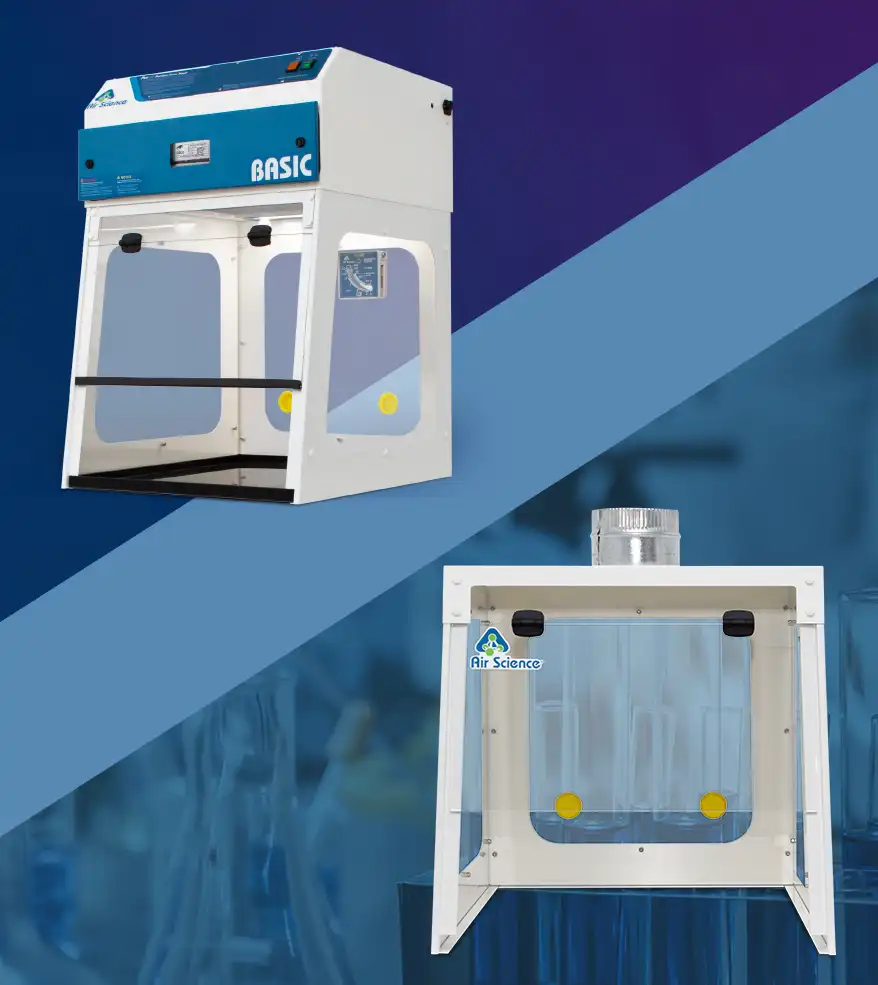We're Here to Help
239.489.0024
Contact Us
info@airscience.com
239.489.0024
info@airscience.com
Air Science manufactures laboratory equipment to meet the needs of a wide range of life science applications.
Browse some of the most popular life science solutions below.
Working with Chemicals
Chemicals used in the laboratory release gases, vapors or fumes that can risk personnel safety. While standard operating procedures (SOPs) can vary between labs, ducted fume hoods or ductless fume hoods are typically required when working with chemicals.
Labs that handle higher volumes of hazardous substances often benefit from the addition of ceiling-mounted filtration units.
Chemical Storage
Chemicals stored in safety cabinets still release vapors that can be harmful to personnel. Modular filtration systems pull fumes from within your safety cabinet to help protect workers and the environment from inhalation risks. Filtration systems either expel fumes through an existing exhaust system or use an activated carbon filter to adsorb vapors and recirculate the filtered air back into the lab.
Some classroom demonstrations produce hazardous fumes. Minimize risks by conducting demonstrations in a ducted or ductless fume hood. Classroom demonstration fume hoods provide the necessary protection while allowing clear viewing of the work surface.
When investigating pollution sources or analyzing samples during environmental science applications, it’s important to use equipment that protects operators or prevents inaccurate results caused by contamination from other sources.
Applications:
Microscopy Procedures
Laminar flow hood microscope enclosures help protect samples on the worksurface while fume hood microscope enclosures provide vapor protection and, when fitted with HEPA or ULPA filtration, particulate protection during applications like asbestos inspection.
Environmental Field Testing
Portable, flexible glove bags provide particulate containment that is used to protect technicians during the collection of potentially harmful substances like suspected asbestos-containing materials.
Working with hazardous biological agents is a common practice in the biological science field. To ensure the safety of both researchers and the environment, biological safety cabinets (BSCs) are essential.
In this highly regulated sector of the laboratory equipment market, biological safety cabinets, or biosafety cabinets, must adhere to NSF standards for airflow patterns and air exchange ratios to ensure operator and product protection.
Some applications that rely on BSCs to minimize the risk of exposure to infection materials or biologicals and protect the product, operator and environment include:
Biological Safety Cabinets
PCR Workstations
Nanoparticle Enclosures
While it may seem like the decision to choose ductless or ducted equipment comes down to your facility’s infrastructure alone, the choice also depends on your application.
Ducted fume hoods may make the HVAC system work harder because they release conditioned air. However, they are the best choice for applications that generate a high volume of fumes or use a wide range of different chemical compounds. While these hoods can have a filter, their main purpose is to extract dangerous fumes through the building’s ducts and release them outside.
Ductless fume hoods use activated carbon filters to extract fumes from the air and then release the filtered air back into the laboratory. As they do not rely on ducts, they are generally more versatile in terms of placement and transportability. There are various filter choices to suit a wide range of chemicals and levels of concentration.

We understand the significance of your research. The breakthroughs you achieve today will contribute to a better tomorrow for everyone. Our products are created with features that prioritize your safety, safeguard your work, and help you achieve accuracy – regardless of your application.
In the life science field, where precision and contamination control are critical, investing in quality laboratory equipment is crucial.
120 6th Street, Fort Myers, FL 33907
Phone: 239.489.0024
Email: info@airscience.com
Learn about our product and design essentials, latest industry news and best practices.